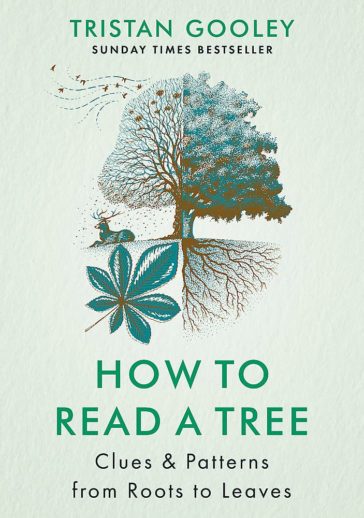HOW TO READ A TREE: Clues & Patterns from Roots to Leaves
Tristan Gooley
Sceptre Hardback (13/4/23)
ISBN 9781529339598
Tristan Gooley’s latest book ‘How to Read a Tree’ continues the themes of his previous publications ‘The Walker’s Guide to Outdoor Clues and Signs’ and ‘How to Read Water’, but with a focus on everything a tree can tell us about its own history, the surrounding landscape, and which direction to walk in. As someone with an interest in trees and dendrology, but limited knowledge, I found this to be a highly readable and interesting book. Gooley highlights many aspects of tree growth and form which may be fairly obvious when pointed out but that are easy to otherwise overlook. I realised that I have been taking for granted the differences between species, and between individual trees within a species, without fully appreciating the underlying causes or advantages that a particular trait may bring.
I particularly enjoyed discovering the reasons behind different tree forms and features, such as broadleaves using tension wood while conifers use compression wood to hold their branches up. I learned that birch and maple trees can grow further north than other deciduous trees because they pump sap upwards in the spring, enabling them to get rid of air bubbles caused by freezing, and also allowing us to tap them for syrup. I’m aware of being unable to walk under the two large spruces in our wood, while being concerned that the lower branches of the Douglas firs will fall from a great height on to our heads, but had never considered why these conifers have such different shapes. I now also know that the white stripes on the underside of the Douglas fir needles are a protective waxy coating around the stomata, and that the distinctive horizontal stripes in the bark of our cherry trees are lenticels for gas exchange.
When out walking I can try to work out if epicormic growth has been triggered by damage to the canopy, ill-health or maybe a change in light levels, knowing how effectively it is normally suppressed by hormonal signals from the leading branches. I try to spot failing branches above paths due to the damaging effects of footfall on the roots that feed them, aware that walking near the trunk is less harmful. And I intend to examine tree stumps more closely, understanding why the heartwood isn’t necessarily in the middle and looking for the stems of climbers engulfed by bark while the tree was growing.
Having read the book in winter with the deciduous trees bare, it was the perfect time to examine patterns of branching, for example identifying straight and zigzag effects in different species and the position of branches in relation to north-south orientation, and also noticing features of bark such as how it changes with age. I’m looking forward to being more aware of leaf and flower development and form throughout the coming seasons. I’d like to be able to identify some trees just from the pattern of veins in their leaves.
The author’s awareness of his slightly eccentric behaviour around trees is endearing, and I enjoyed his descriptions of exploring various wooded landscapes both close to home and abroad. He provides the tools and encouragement needed to get out and notice things for ourselves, making a point of distinguishing between useful generalisations and unnecessary detail. I’m not sure that I share his fondness for rhyming couplets as memory aids but others may find these useful! Some of his analogies, such as the tortoise and hare comparison for climax and pioneer trees, will stick with me.
A number of the effects described, such as how trees are broadly shaped by wind and light, were already familiar to me, and I’m sure that those with professional knowledge will be aware of many of the concepts. However, most woodland enthusiasts are likely to gain a deeper understanding and connection with trees from this book. It has certainly made me see trees in a new light, and reinforced a desire to visit different types of woodland to look for all the things that they can tell us. Maybe I’ll even try to navigate by them.
